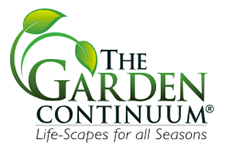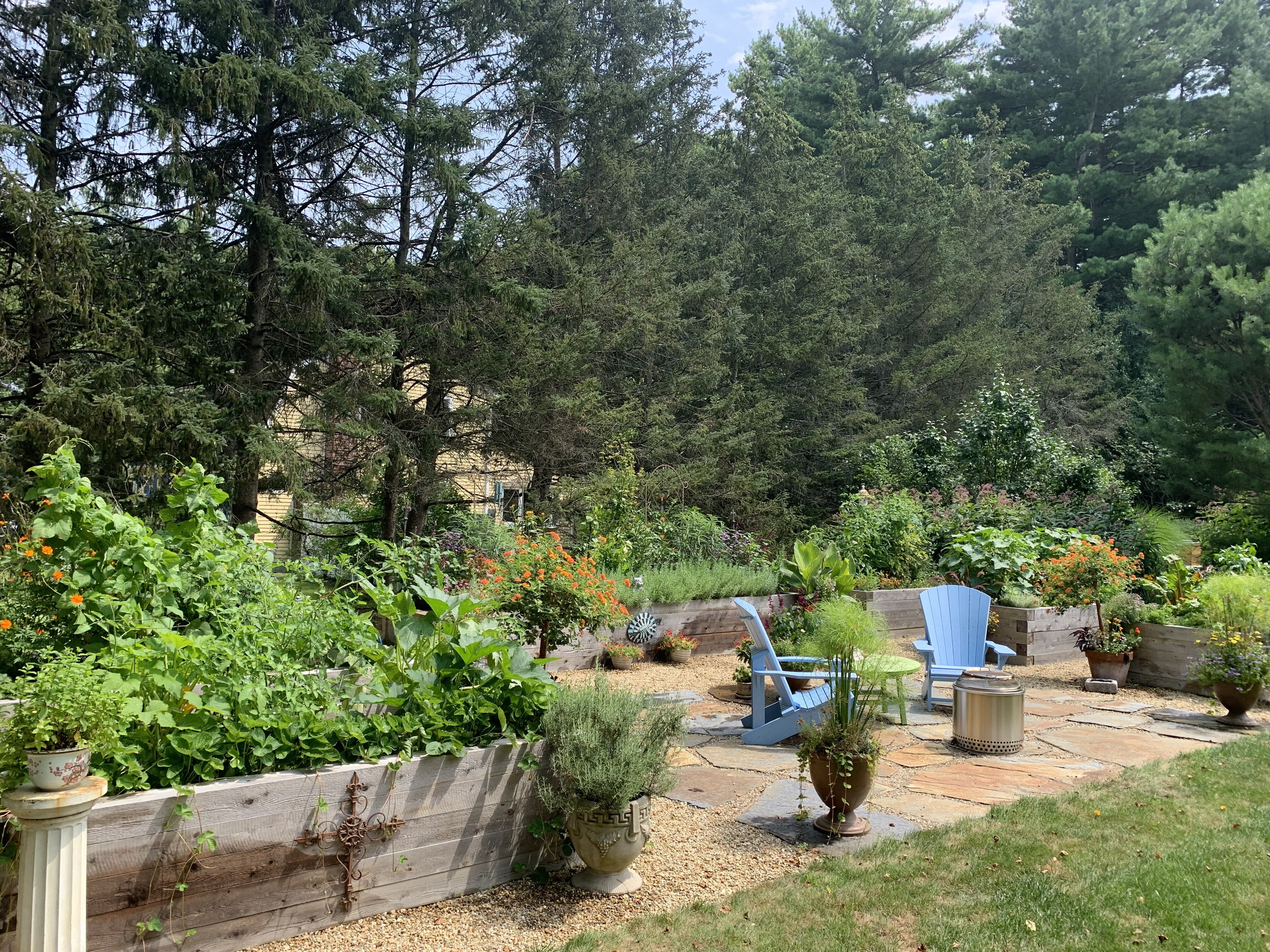The Garden Continuum, a landscape design/build and fine gardening company based in Medfield, Massachusetts, has been transforming outdoor spaces since 1991. Our mission is to create beautiful, environmentally friendly landscapes that draw you into them to play, entertain, and rest your bones, minds, and hearts when nothing is better than nature to restore you. We call these spaces “Life-Scapes”.
Vegetable gardening is an excellent add-on benefit to any Life-Scape. More than just the crisp taste and easy access to homegrown produce, home veggie plots are a step in the right direction for reducing your carbon footprint by cutting down on transportation and packaging. The most rewarding aspect is the connection to nature you cultivate as you nurture your plants from seed to harvest, gaining a deeper appreciation for the natural world.
Planning Your Sustainable Veggie Patch:
Sitting your garden—Choosing the perfect spot for your garden is essential to a bountiful harvest. Sunlight is a top priority, with most vegetables needing at least six hours of direct sunlight daily. Leafy greens like lettuce can tolerate some shade (preferring protection from the heat of the midday sun), while tomatoes and peppers crave all the sun they can get. Drainage is equally essential. Avoid low-lying areas or compacted soil that can drown plant roots.
Ideal Garden Soil—Well-draining, slightly loamy soil that balances silt, sand, and clay in equal parts is the best option for growing vegetables. Working in compost to increase the organic matter to about 10% will further boost your bounty by providing food for the soil biology that will support your crops. If your soil isn't ideal, consider raised beds. There are some great options at Gardener’s Supply, and if you want to go all out, check out Durable Green Bed. Raised planter boxes allow you to control the quality of the planting medium and improve drainage. Container gardens are another option for small spaces or patios. Choose pots or troughs large enough for the vegetables you plan to grow, fill them with rich soil, and work in a little potting soil (about 20%) to keep the soil from getting too heavy. Ensure the pots have good drainage at the bottom of the soil medium (rocks or broken clay pots, or even old plastic water bottles in the bottom) and that the containers have drainage holes to allow excess water to drain out.
Crop Watering Strategies—Drip irrigation is the most environmentally friendly way to water plants because it delivers water directly to plant roots, minimizing waste through evaporation and wind drift. If you can’t install an automated drip system, try ½ inch soaker hoses woven through the crops. Invest in a battery-operated, programable timer to deliver water even while you are at work or tending to the demands of daily life. Top the garden soil off with organic mulch, like shredded leaves, denatured straw, buckwheat hulls, or a light layer of untreated bark mulch. This conserves moisture, suppresses weeds, and keeps the soil cool while fostering a thriving, eco-friendly garden.
Growing Through the Seasons:
Maintaining Your Garden for Long-Term Success - Long-term garden success hinges on proper maintenance. For a natural approach to pest control, try companion planting. Certain herbs like rosemary deter unwanted insects while attracting beneficial predators like ladybugs. Plants like fennel can fend off bunnies, and garlic can fend off deer. It’s not a perfect system, but it’s worth considering. Watering is crucial, but be strategic. Deep watering less frequently encourages strong root growth, while daily shallow watering can lead to weak, shallow roots. Tailor your watering practices to the season and specific needs of your plants. Successful veggie gardeners pay attention to the weather forecasts, tending to their watering practices accordingly. To minimize disruption to the soil's ecosystem, focus on weeding techniques like frequent hand-pulling while the weeds are still small before they flower or set seeds. This helps you get ahead of the seeding cycle and avoids harming beneficial organisms in the soil. Finally, if you are composting your kitchen scraps, you can add this nutrient-rich compost to feed your soil throughout the season, promoting healthy plant growth while reducing landfill waste. For more in-depth composting guidance, check out "Let It Rot" by Stu Campbell – a valuable resource for creating a thriving garden ecosystem.
Adapting Your Garden to Different Vegetables - To keep your veggie garden thriving and productive throughout the season, adapt your planting strategy to suit different vegetables. First, understand each plant's spacing requirements. Crowding them can stunt growth and reduce yields. Next, group vegetables with similar water and sunlight needs together. Sun-loving tomatoes will appreciate being neighbors with peppers, while leafy greens can share a spot with low-growing herbs that prefer partial shade. Utilize the concept of succession planting by incorporating cool-season crops like lettuce and peas in early spring, followed by warm-season vegetables like tomatoes and peppers as temperatures rise. This ensures a continuous harvest throughout the growing season. Over the years, plan to rotate your crops by dividing them into these primary groups: Legumes (like beans), Root Crops (like carrots), Fruit Crops (like tomatoes), and Leaf Crops (like lettuce). Each year, these four groups are planted in different garden areas. If you have four raised garden beds, move them from bed one to two, two to three, and so on. If you only have one garden bed, section the bed into four areas and rotate through the areas. The ideal situation is to have one bed or area lie fallow (unplanted) each year so you can add a nitrogen-fixing cover crop to boost soil fertility.
Choosing Your Culinary Bounty:
Selecting Vegetables Based on Your Climate and Preferences - Selecting vegetables that thrive in your climate and tantalize your taste buds is critical to a successful garden. For beginners, consider easy-to-grow options like lettuce, spinach, radishes, and green beans. These require minimal fuss and provide a quick turnaround from seed to harvest. Purchase your plants as “starts” at a local nursery and plan your plantings around the seasons. Spring offers a perfect opportunity for cool-weather crops like peas, carrots, and beets. Enjoy the bounty of tomatoes, peppers, and cucumbers as summer arrives. Extend your harvest into fall with leafy greens, broccoli, and even some late-season squash varieties. Don't forget the herbs and edible flowers! Herbs like basil and parsley add a burst of flavor to dishes, while colorful blooms like nasturtiums can grace your salads and add a pop of color to your garden. Opt for compact varieties or vertical gardening techniques if you have limited space to plant. Think about what you enjoy eating the most, and prioritize those vegetables for a truly rewarding garden experience. Seeds deserve an honorable mention here. For those interested in heirloom plants and seed saving, check out this blog, which goes into more detail: How to Save Money Growing Fun And Exciting Seasonal Plants.
Wrap It Up & Get Planting:
Sustainable vegetable gardening is a delightful activity that nourishes your body and soul while creating a connection with nature, family, and friends when you share the work. Witnessing the magic of seeds transforming into fresh, flavorful produce while fostering a healthy ecosystem is a truly rewarding experience for children and adults alike. The Garden Continuum is here to help you every step of the way. We offer personalized garden design and installation services to create flourishing home vegetable gardens tailored to your needs, preferences, and unique property. To read more, check out this blog, Home Vegetable Garden, which chronicles the creation of our founder Monique Allen’s early gardening with her children and her 2020 potager garden installation, along with some of our client’s veggie plots. Happy planting!
Learn more about Fine Gardening by downloading the eBook titled "The Fine Gardeners Guide to a Beautiful and Luxurious Landscape" today.








Leave a comment